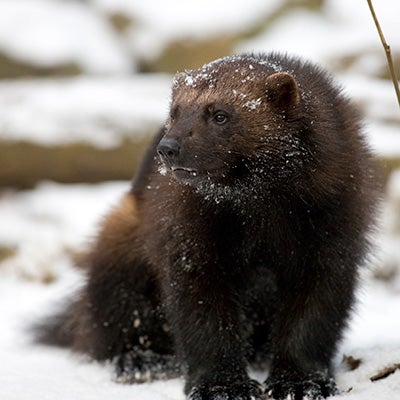Winning One for the Wolverine
Managing Attorney Tim Preso isn’t likely to square off against a grizzly bear—as wolverines do—but he’s figured out how to use the persistence and determination of a wolverine to keep it from going extinct in the continental United States.

Once decimated by traps and poison, only a few hundred wolverines remained at the turn of this century when Tim Preso, the managing attorney of Earthjustice’s Northern Rockies office, took up their cause against an unsympathetic state government and the George W. Bush administration.
The biggest terrestrial member of the weasel, mink, marten and otter family, wolverines generally are loners that cover vast ranges, usually in mountains high above the tree line in rock, ice and snow. They are slow to reproduce and notoriously elusive. Even experienced backcountry travelers may go a lifetime without encountering a wolverine.
No one knows exactly how many wolverines still exist in the 48 contiguous states, but thanks to researchers like biologist Doug Chadwick we know their numbers are fewer than 300, most of them in the Rocky Mountains of Montana, Wyoming and Idaho, and the North Cascades of Washington. Two individuals are known to have dispersed to California and Colorado. Field researchers in Montana and Idaho had alerted Preso to the wolverines’ plight. Already rare in the lower-48, wolverines face looming new threats as a warming climate erodes their habitat, which is centered on persistent, deep alpine snowpack. On top of that threat, Montana’s anachronistic recreational trapping season for wolverines annually kills several wolverines in their last remaining strongholds.
Wolverines are persistent, relentless animals known to scale virtually vertical ice cliffs to get where they’re going. They don’t quit and they don’t back down—anymore than Preso did during 12 years of struggle in and out of the courtroom as Earthjustice sought federal Endangered Species Act protections for this rare mammal.
Preso began the fight in 2000 by supporting a petition by conservationists asking the U.S. Fish and Wildlife Service to add the wolverine to the federal list of endangered and threatened species.
When the FWS refused to act, Preso successfully went to federal court to force the agency to respond.
In 2003 the agency, then under the Bush administration (no friend to the Endangered Species Act), said there wasn’t enough evidence to warrant protecting wolverines, so Preso again took them to court. A federal judge ruled Preso was right and that the FWS ignored “substantial scientific information” demonstrating threats to wolverines. That ruling sent the agency back to the drawing board to reconsider protecting wolverines.
The FWS returned in 2008, with Bush still in the White House, and repeated its view that wolverines didn’t warrant ESA protections. Preso returned to court and forced the agency to reconsider its finding once more. In 2010, with Barack Obama in the White House, the service finally admitted that wolverines actually did warrant federal protection, but said further action would be delayed because of other priorities.
Fortunately, the fate of the wolverine then became bound up in a larger debate over a regulatory backlog of other species that, like the wolverine, were slipping towards extinction while the FWS dallied. This led to an agreement with the FWS to issue final decisions on a list of species, including the wolverine.
Finally, in February of 2013 the federal government proposed to protect wolverines as a threatened species under the Endangered Species Act. Among other things, this listing, if finalized, would put an end to wolverine trapping in Montana.
“The wolverine is one of those iconic wildlife species that make our wildest places wilder,” Preso said. “Legal protections will give the remaining wolverines in the lower-48 a fighting chance to survive the impacts that we are inflicting on their—and our—climate.”
Written by John McManus.
First published in the Earthjustice Quarterly Magazine, Spring 2013 issue.
